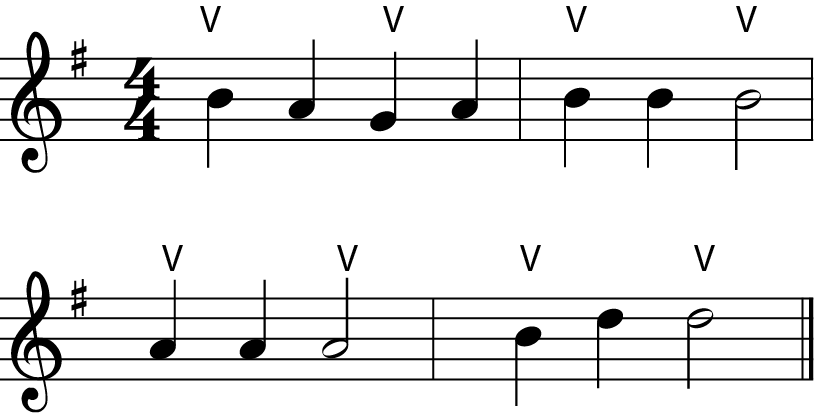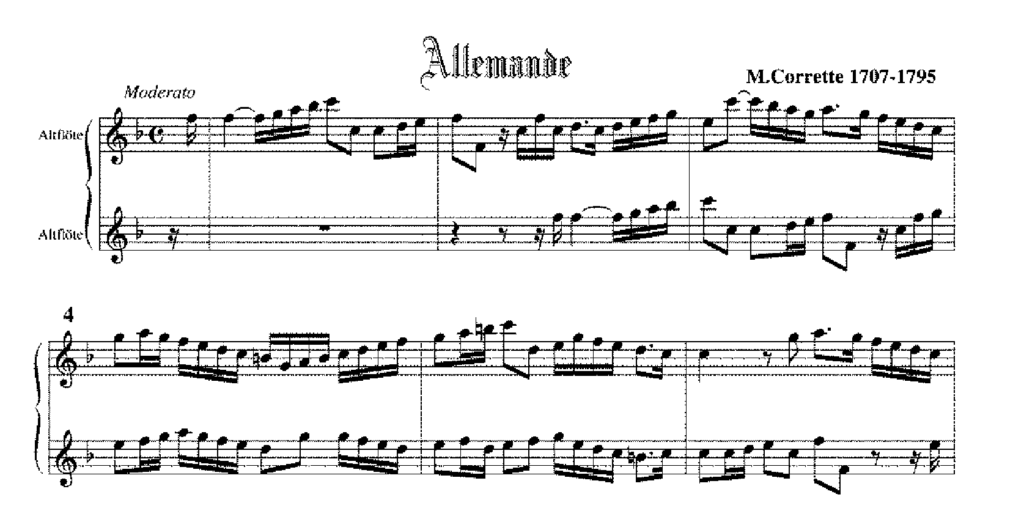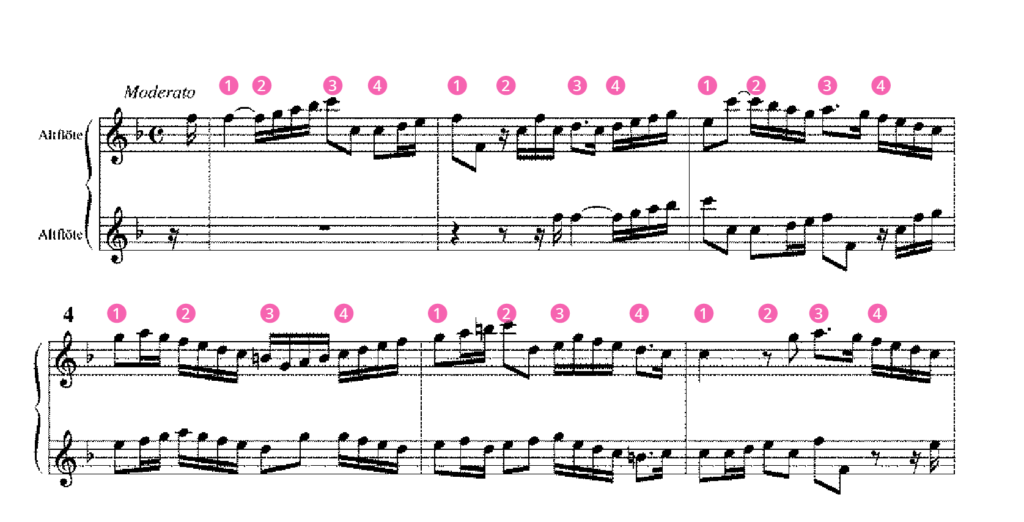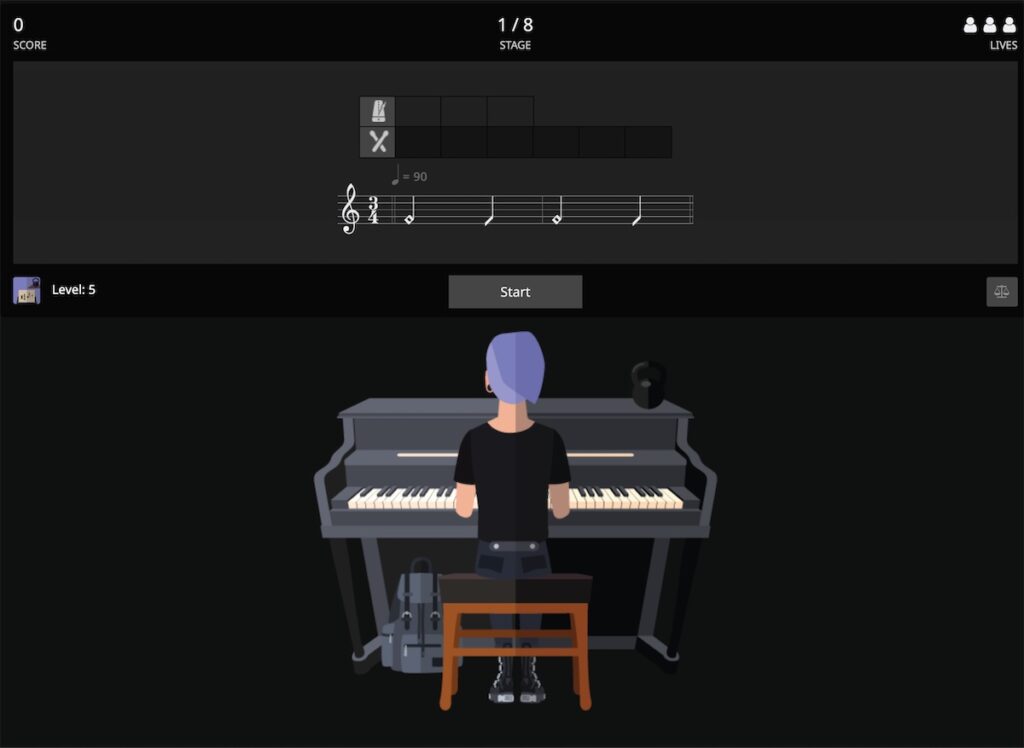The most popular meter (or time signature) in modern music is 4/4. Each measure (or bar) of 4/4 has 4 quarter note beats in it. This time signature is so widely used the we sometimes call it common time.
We’re going to dive straight into 4/4 time, but you can find more info on what a time signature in our complete guide to meters.
What is time signature 4/4?
4/4 time is written with 2 fours, one on top of the other, at the start of the music.

The time signature is always written after the clef and after the key signature (the sharps of flats in the piece). Following the time signature we have the first note of the piece of music.
Take a look at this famous tune written in 4/4 time. Can you spot the 4 crotchet beats per measure? (It’s ‘Mary Had a Little Lamb’ if you didn’t get it!)

Now look at the image below where the four quarter note beats have been labelled.

We often refer to time signature 4/4 as simple quadruple! Simple time signatures have signature have beats that divide into two: each quarter note divides into two eighth notes. And quadruple time signatures have four beats per measure.
What is 4/4 time called?
Time signature 4/4 is also referred to as common time. Having four quarter notes in a bar (four crotchet beats) is the most regular way to count a piece. To reflect this we sometimes simply draw a C at the start of the music. The C stands for Common Time.

It is also possible to have what we call ‘cut time’ this is very similar to 4/4 time but rather than counting four quarter note beats per measure, we actually count two half note beats per measure. A half note is worth two quarter note beats!
How To Count in 4/4
To count in time signature 4/4 time we simply count the four beats. This will be 1, 2, 3, 4, 1, 2, 3, 4 and so on.
However, when counting in a time signature, we have to think about how many strong beats and how many weak beats we have in each bar/measure.
In 4/4 we have four beats. The first beat is a strong beat, the second beat is a weak beat, the third beat is a strong beat and the fourth beat is a weak beat. This simply refers to where the emphasis will go in the bar!

Here is the score for ‘Allemande in C Minor’ (BWV 834) by Bach. The piece is in 4/4 but is a bit more complex nursery rhymes! Can you spot were each beat falls?

Now here it is with the beats added.

4/4 Is A Simple time signature
4/4 is simple (not compound) time signature. Time signatures fall into two groups within western classical music: compound time signatures and simple time signatures. There are also time signatures that are considered irregular or odd time signatures.
A simple time signature has beats that divide into two and a compound time signature has beats that divide into three. Irregular time signatures are more unusual time signatures as the beats cannot be divided equally. To learn more about the differences check out our ultimate guide to time signatures.
The notes below show how each quarter note beat in 4/4 time can be divided into two eight notes.

Songs with a 4/4 Time Signature
Guns N’ roses – Sweet Child o Mine
When the drums kick in you can hear the accented 1st and 3rd beats. The first beat with the bass drum and 3rd beat with the snare.
Tool – The Pot
This is a great example of time signature 4/4 that does not have accents on the 1st and 3rd beats. In fact the drummer, Danny Carey, makes it tough to count this in 4/4 as he plays lots of off-beat rhythms. To get around this, focus on the the 1st beat of each measure and you can count along to this song.
Ear Training and Meters
To develop as a musician you’ll want to be able to recognise time signatures by ear. This is where ear training comes in, as the more you practice, the better your’ll get.
My recommendation for this is Tonegym as they have a comprehensive and fun program for training your ears. It’s what has gotten the best results with for my own students.
They have a great game called ‘Rhythmania’, were you have to read rhythms in different meters and tap them back using the spacebar. I like how Tonegym structure the game so it always gives you the right level of challenge.
For an in-depth look at ear training, here’s my full review of Tonegym.

What next…?
If you want to learn more about time signatures, check out our complete guide to meters.
What to learn more about music theory, take a look at our guide to the circle of fifths here.
FAQs
How many beats are in 4/4 time signature?
Their of four quarter-note beats per measure in a piece written in 4/4. Another way of saying this is that there are four crotchet beats per bar.
What is the best example of 4/4 time?
A brilliant example of time signature 4/4 is ‘Baa Baa Black Sheep’. This nursery rhyme is in
How is 4/4 time signature pronounced?
We say ‘four four time’ to pronounce this time signature correctly. It can also be called ‘common time’.
What is the tempo of 4/4 time?
Tempo is a separate concept to the time signature. Time signatures give you the rhythmic pattern of the music, whereas the tempo is how fast those rhythms are played.
What is a Time Signature?
In music theory, the time signature (or meter) is placed at the start of a piece of music to indicate how many beats within each bar (beats per measure). This is different to your key signature which indicates what sharps or flats you should play in your piece – to learn more about key signatures make sure to visit out ultimate guide. It is important as a music learner to be aware of time signatures as it will make it a lot easier to read your sheet music!
In this short series of time signature/meter posts we will look at the basic time signatures you should feel confident with to read western music.
Time Signatures consist of two numbers, one on top of the other, very similar to what a fraction looks like. The top number in the time signature tells you how many beats there are in each bar. Most commonly this will be two beats, three beats or four beats and the bottom number tells you what type of beats (note lengths) that you will need to count in. Most commonly this will be eighth notes (quavers), quarter notes (crotchets) and half notes (minims). We don’t often count using a whole note (semibreve) beat as this would be a little too long! Although it is not impossible you could see this, it is certainly very rare!
By using a time signature it is easier for the performer to count and play the music effectively. A time signature helps to show you the beat pattern of the piece of music and helps to quickly and easily read the pattern of notes.
